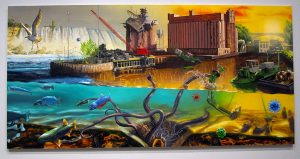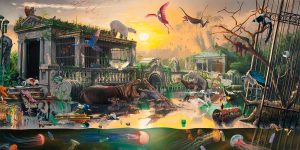Aleah Smith – Alexis Rockman: “Environmental Dystopia”
Aleah Smith
Environmental Dystopia
Alexis Rockman: “Environmental Dystopia” is about dystopian environmental art that concentrates particularly on the artist, Alexis Rockman. Rockman is a well known artist, whose insightful creative expression highlights the consequential corruption of Earth’s natural resources, as well as the destruction and invasion of its largest ecosystems. Pieces by Rockman are exceptionally perceptive portrayals of a near-future dystopian environment, focusing on his intricate illustrations of the contamination of Earth’s beautiful landscapes and vast bodies of water. Alexis Rockman’s views of environmental degradation and intoxication prove to be significant, especially in the way that Rockman confronts the social and political issues surrounding climate change in today’s society. Works by Rockman allow his audience(s) a glimpse into a potentially inevitable environmental dystopia if actions are not taken against mankind’s excessive consumption and pollution, and the impact it could leave on Earth.



As seen in his pieces, Rockman uses reoccurring themes to establish his view of climate change and environmental issues, and the disastrous consequences they could lead to. The first theme that I would like to call attention to is the representation of human excess, and the traumatized environments left behind as a result. Rockman includes altered and toxic natural landscapes which can be seen in pieces such as Gowanus and Bronx Zoo. These two works of art indicate the representation of environmental dystopia, and the aftermath of pollution. For instance, as seen in Gowanus, Rockman illustrates the abundance of toxic waste that makes its way into Earth’s ecosystems, painting them as vibrant colors, into the contrasting bleak and decaying waters. This can also be seen in his piece, Bronx Zoo, in which the way he paints the dirty, polluted water against the vibrant, overgrown vegetation scattered across manmade structures. The second theme I would like to point out is the depiction of Earth’s creatures, moreover, the surviving species, whose environments have been devastated by humanity’s downfall and creation of global warming. Rockman portrays the threatened futures of these animals in works such as Forces of Change and Bronx Zoo. In each of these oil paintings, Alexis Rockman foreshadows environmental dystopia in the forms of mutated animals, invaded ecosystems, and endangered species. Each of Rockman’s pieces included in this portfolio display his views on the ecological conflicts brought by man and its everlasting consequences for our planet, and its future.
All the works that have been included in this portfolio, “Environmental Dystopia”, are by Alexis Rockman. Growing up, Rockman lived in New York City, and frequently would visit the American Museum of Natural History where his mother was an anthropologist. As a child he enjoyed learning about natural sciences and arts, where he eventually attended the School of Visual Arts, for a Bachelor in Fine Arts. He worked for different conversation groups, such as the Riverkeeper project and the Rainforest Alliance. Many of Alexis Rockman’s works were inspired by his travels and research tours of different environments around the globe such as the Great Lakes Region, Guyana, Galapagos Islands, and Antarctica. A collection of his works, including the piece Forces of Change, painted in 2017, were explorations of the ecologically complex and important Great Lakes region, where Rockman exhibited the global significance of understanding the threatening factors of urban sprawl and climate change against those ecosystems. The next two pieces included in this portfolio, Bronx Zoo and Gowanus, were part of Rockman’s 2013 exhibition titled “Rubicon” which focused on different aspects of the contamination of New York City’s environmental scenes, such as Brooklyn’s Gowanus Canal, and the Bronx Zoo habitats. Rockman was prompted to explore the destruction of these natural resources and environments in “Rubicon” (named after the expression made by Julius Caesar, meaning the “point of no return”) because of his belief that our natural world has began to suffer irrevocable damage, leading to a potentially disastrous near-future environmental dystopia. Overall, his depictions and explorations in these works, have allowed his audiences to understand his dark and apocalyptic visions of humanity’s environmental impact, and the consequences they may have for future generations.
Alexis Rockman’s works are very significant in understanding the industrialized and rapidly changing environmental society in which it was created. His work creatively portrays the possibly inevitable future that awaits for our planet and its ecosystems, especially if the importance of taking action for the environment is not recognized. Alexis Rockman’s works are exceptionally notable and unorthodox in his depictions of dystopian environments because he is one of a few artists who uses his creative expression to confront social and political issues in today’s day and age. Likewise, activist Alexis Rockman is also one of the only artists (that he claims) who believes “the idea that art can make a difference in terms of political change.”

